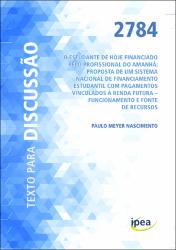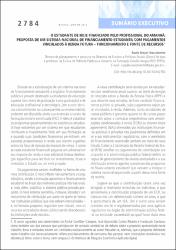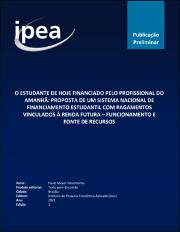Please use this identifier to cite or link to this item:
https://repositorio.ipea.gov.br/handle/11058/11259Full metadata record
| DC Field | Value | Language |
|---|---|---|
| dc.contributor.author | Nascimento, Paulo Meyer | - |
| dc.coverage.spatial | Brasil | pt_BR |
| dc.date.accessioned | 2022-07-27T20:42:27Z | - |
| dc.date.available | 2022-07-27T20:42:27Z | - |
| dc.date.issued | 2022-07 | - |
| dc.identifier.uri | http://repositorio.ipea.gov.br/handle/11058/11259 | - |
| dc.description.abstract | Neste estudo, propõe-se um sistema público-privado de assistência financeira para estudantes de educação superior (ES) e de educação profissional e tecnológica (EPT). Funciona tanto como um seguro (só paga de volta se tiver renda compatível) quanto como um sistema de repartição às avessas (estudantes do passado financiam estudantes do presente). Estudantes teriam a possibilidade de contratar financiamentos oferecidos por instituições públicas e privadas nos parâmetros definidos em lei e por instrumentos regulatórios, sem necessariamente atrelar o financiamento contratado ao pagamento de encargos educacionais de qualquer natureza. O funcionamento do sistema pressupõe a introdução de uma nova contribuição no Sistema Tributário Nacional (STN). O novo tributo não aumenta a carga tributária, mas é central à proposta por ser a forma de viabilizar que a Receita Federal recolha pagamentos proporcionais à renda das pessoas financiadas. O novo tributo alcançaria ainda estudantes de cursos gratuitos ou com matrícula em cursos pagos, estes financiados pelo Estado. Assim, financia-se a expansão do segmento público e reduz-se o custo fiscal da assistência a estudantes do segmento privado. Ademais, o sistema proposto busca remover assimetrias que atravancam o mercado privado de crédito educativo e de investimento em pessoas. | pt_BR |
| dc.language.iso | pt-BR | pt_BR |
| dc.publisher | Instituto de Pesquisa Econômica Aplicada (Ipea) | pt_BR |
| dc.title | O Estudante de hoje financiado pelo profissional do amanhã : proposta de um sistema nacional de financiamento estudantil com pagamentos vinculados à renda futura – funcionamento e fonte de recursos | pt_BR |
| dc.title.alternative | Texto para Discussão (TD) 2784 : O Estudante de hoje financiado pelo profissional do amanhã : proposta de um sistema nacional de financiamento estudantil com pagamentos vinculados à renda futura – funcionamento e fonte de recursos | pt_BR |
| dc.type | Texto para Discussão (TD) | pt_BR |
| dc.rights.holder | Instituto de Pesquisa Econômica Aplicada (Ipea) | pt_BR |
| dc.source.urlsource | http://www.ipea.gov.br | pt_BR |
| dc.location.country | BR | pt_BR |
| dc.description.physical | 66 p. : il. | pt_BR |
| dc.subject.vcipea | IPEA::Educação. Treinamento::Sistemas Educacionais::Níveis de Ensino::Ensino Superior | pt_BR |
| dc.subject.vcipea | IPEA::Educação. Treinamento::Desenvolvimento da Educação. Política Educacional::Financiamento da Educação::Financiamento da Educação | pt_BR |
| dc.subject.vcipea | IPEA::Educação. Treinamento::Sistemas Educacionais::Educação Profissional::Ensino Profissional | pt_BR |
| dc.rights.license | É permitida a reprodução deste texto e dos dados nele contidos, desde que citada a fonte. Reproduções para fins comerciais são proibidas. | pt_BR |
| dc.subject.keyword | Educação superior | pt_BR |
| dc.subject.keyword | Educação profissional e tecnológica | pt_BR |
| dc.subject.keyword | Financiamento estudantil | pt_BR |
| dc.subject.keyword | Contribuição financeira de ex-estudantes | pt_BR |
| dc.subject.keyword | Financiamentos com pagamentos vinculados à renda futura | pt_BR |
| ipea.description.additionalinformation | Série monográfica: Texto para Discussão ; 2784 | pt_BR |
| ipea.description.additionalinformation | Possui referências bibliográficas; | pt_BR |
| ipea.access.type | Acesso Aberto | pt_BR |
| ipea.rights.type | Licença Comum | pt_BR |
| ipea.englishdescription.abstract | It is proposed a broad two-tier income-contingent financing system for postsecondary students, designed for public and private providers and consisting of both income-contingent loans (ICLs) and income share agreements (ISAs), with repayments to be collected by the Federal Revenue System (FRS). Both students enrolled in tuition-free publicly run programmes and students enrolled in fee-paying programmes would be able to contract either ICLs or ISAs offered by both public and private financial institutions within the parameters defined by law and by regulatory instruments, without necessarily linking their ICLs and ISAs to the payment of tuition fees or other educational charges. In the case of students with no fees to pay (either because enrolled at tuition-free public institutions or attending fee-paying programmes totally or partially funded by the Government), the cost of the financial aid provided by the State would be added to the balances of the ICL or ISA accounts linked to their respective social security numbers. ICLs and ISAs contracted with duly certified financial institutions would also be accounted for in the balances of the individual accounts of students who resorted to such financing tools, and the law or other regulatory instrument must define debt ceilings. Repayments would be made in two different ways. Either debtors advance repayments directly to the organisation regulating the proposed system or postpone them and pay the debt through the tax system. This paper proposes legislative reforms to set the grounds to the new student funding system, which includes incorporating the tax-like contribution to the national tax system (as the way to involve the FRS in the repayment collection) as well as making the constitutionally mandatory free-of-charge provision in the public sector compatible with the collection of the new tax-like contribution from all graduates from public universities and VET institutions. | pt_BR |
| ipea.researchfields | N/A | pt_BR |
| ipea.classification | Educação | pt_BR |
| Appears in Collections: | Educação: Livros | |
Files in This Item:
| File | Description | Size | Format | |
|---|---|---|---|---|
| td_2784.pdf | 1.59 MB | Adobe PDF |  View/Open | |
| td_2784_sumex.pdf | 266.24 kB | Adobe PDF |  View/Open | |
| publ_preliminar_td_o_estudante_de_hoje (1).pdf | 1.48 MB | Adobe PDF |  View/Open |
Items in DSpace are protected by copyright, with all rights reserved, unless otherwise indicated.

